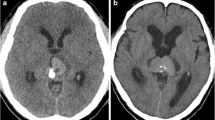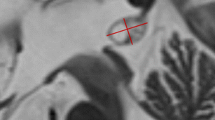Abstract
Introduction
Quantitative values of CT attenuation, apparent diffusion coefficient (ADC), and standardized uptake value (SUV) were investigated for differentiation between pineal parenchymal tumors (PPTs) and germinomas. Differences in age, sex, and calcification pattern were also evaluated.
Methods
Twenty-three patients with PPTs and germinomas in 20 years were retrospectively enrolled under the approval of the institutional review board. CT attenuation, ADC, and SUV (20, 13, and 10 patients, respectively) were statistically compared between the two tumors. Differences in sex and patterns of calcification (“exploded” or “engulfed”) were also examined. Mean patient ages were compared among three groups of pineoblastoma, pineal parenchymal tumor of intermediate differentiation, (PPTID) and pineocytoma and germinoma.
Results
None of the quantitative values of CT attenuation, ADC, and SUV showed significant differences between PPTs and germinomas (p > .05). However, there was a significant difference in age (p < .05) among the three groups of pineoblastoma (mean age ± standard deviation 7.0 ± 8.7 years), PPTID, and pineocytoma (53.7 ± 11.4 years) and germinoma (19.1 ± 8.1 years). Sex also showed significant differences between PPTs and germinomas (p = .039). Exploded pattern of calcification was found in 9 of 11 PPT patients and engulfed pattern in 7 of 9 patients with germinomas. No reverse pattern was observed, and the patterns of calcification were considered highly specific of tumor types.
Conclusions
None of the quantitative imaging values could differentiate PPTs from germinomas. Age, sex, and calcification patterns were confirmed useful in differentiating these tumors to some degree.





Similar content being viewed by others
References
Senft C, Raabe A, Hattingen E, Sommerlad D, Seifert V, Franz K (2008) Pineal parenchymal tumor of intermediate differentiation: diagnostic pitfalls and discussion of treatment options of a rare tumor entity. Neurosurg Rev 31(2):231–236. doi:10.1007/s10143-008-0126-8
Smith AB, Rushing EJ, Smirniotopoulos JG (2010) From the archives of the AFIP: lesions of the pineal region: radiologic-pathologic correlation. Radiographics 30(7):2001–2020. doi:10.1148/rg.307105131
Han SJ, Clark AJ, Ivan ME, Parsa AT, Perry A (2011) Pathology of pineal parenchymal tumors. Neurosurg Clin N Am 22(3):335–340. doi:10.1016/j.nec.2011.05.006, vii
Gaillard F, Jones J (2010) Masses of the pineal region: clinical presentation and radiographic features. Postgrad Med J 86(1020):597–607. doi:10.1136/pgmj.2009.087460
Horowitz MB, Hall WA (1991) Central nervous system germinomas. A review. Arch Neurol 48(6):652–657
Lekovic GP, Gonzalez LF, Shetter AG, Porter RW, Smith KA, Brachman D, Spetzler RF (2007) Role of Gamma Knife surgery in the management of pineal region tumors. Neurosurg Focus 23(6):E12. doi:10.3171/FOC-07/12/E12
Louis D, Ohgaki H, Wiestler O, Cavenee W et al (2007) The 2007 WHO classification of tumours of the central nervous system. 4th edition. World Health Organization. Acta Neuropathol 114(2):97–109
Wilson DA, Awad AW, Brachman D, Coons SW, McBride H, Youssef E, Nakaji P, Shetter AG, Smith KA, Spetzler RF, Sanai N (2012) Long-term radiosurgical control of subtotally resected adult pineocytomas. J Neurosurg 117(2):212–217. doi:10.3171/2012.5.JNS1251
Pusztaszeri M, Pica A, Janzer R (2006) Pineal parenchymal tumors of intermediate differentiation in adults: case report and literature review. Neuropathology 26(2):153–157
Fauchon F, Jouvet A, Paquis P, Saint-Pierre G, Mottolese C, Ben Hassel M, Chauveinc L, Sichez JP, Philippon J, Schlienger M, Bouffet E (2000) Parenchymal pineal tumors: a clinicopathological study of 76 cases. Int J Radiat Oncol Biol Phys 46(4):959–968
Tate MC, Rutkowski MJ, Parsa AT (2011) Contemporary management of pineoblastoma. Neurosurg Clin N Am 22(3):409–412. doi:10.1016/j.nec.2011.05.001, ix
Ganti SR, Hilal SK, Stein BM, Silver AJ, Mawad M, Sane P (1986) CT of pineal region tumors. AJR Am J Roentgenol 146(3):451–458. doi:10.2214/ajr.146.3.451
Smirniotopoulos JG, Rushing EJ, Mena H (1992) Pineal region masses: differential diagnosis. Radiographics 12(3):577–596
Korogi Y, Takahashi M, Ushio Y (2001) MRI of pineal region tumors. J Neurooncol 54(3):251–261
Reis F, Faria AV, Zanardi VA, Menezes JR, Cendes F, Queiroz LS (2006) Neuroimaging in pineal tumors. J Neuroimaging 16(1):52–58. doi:10.1177/1051228405001514
Bakheet SM, Hassounah M, Al-Watban J, Homsi M, Powe J, Larsson S (1999) F-18 FDG PET scan of a metastatic pineoblastoma. Clin Nucl Med 24(3):198–199
Park SA, Kim TY, Choi SS, Yang CY, Kim HS, Choi KH (2012) (1)(8)F-FDG PET/CT imaging for mixed germ cell tumor in the pineal region. Clin Nucl Med 37(3):e61–e63. doi:10.1097/RLU.0b013e31823926fc
Carrasco JL, Jover L (2003) Estimating the generalized concordance correlation coefficient through variance components. Biometrics 59(4):849–858
Busing KA, Kilian AK, Schaible T, Debus A, Weiss C, Neff KW (2008) Reliability and validity of MR image lung volume measurement in fetuses with congenital diaphragmatic hernia and in vitro lung models. Radiology 246(2):553–561. doi:10.1148/radiol.2462062166
Dumrongpisutikul N, Intrapiromkul J, Yousem DM (2012) Distinguishing between germinomas and pineal cell tumors on MR imaging. AJNR Am J Neuroradiol 33(3):550–555. doi:10.3174/ajnr.A2806
Sasaki M, Yamada K, Watanabe Y, Matsui M, Ida M, Fujiwara S, Shibata E, Acute Stroke Imaging Standardization Group-Japan (ASIST-Japan) Investigators (2008) Variability in absolute apparent diffusion coefficient values across different platforms may be substantial: a multivendor, multi-institutional comparison study. Radiology 249(2):624–630. doi:10.1148/radiol.2492071681
Conflict of interest
We declare that we have no conflict of interest.
Author information
Authors and Affiliations
Corresponding author
Rights and permissions
About this article
Cite this article
Kakigi, T., Okada, T., Kanagaki, M. et al. Quantitative imaging values of CT, MR, and FDG-PET to differentiate pineal parenchymal tumors and germinomas: are they useful?. Neuroradiology 56, 297–303 (2014). https://doi.org/10.1007/s00234-014-1334-2
Received:
Accepted:
Published:
Issue Date:
DOI: https://doi.org/10.1007/s00234-014-1334-2




